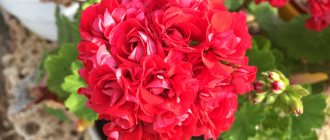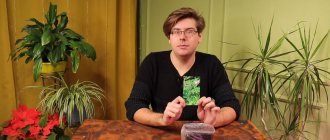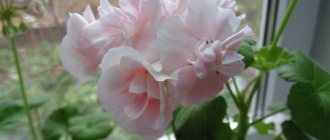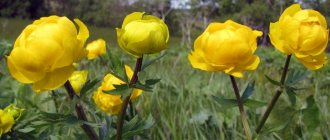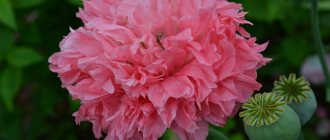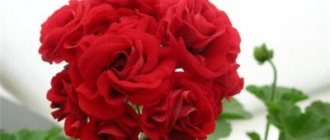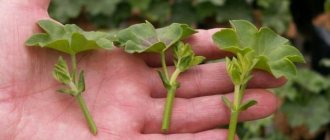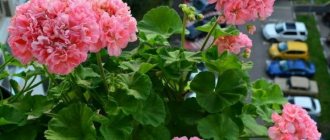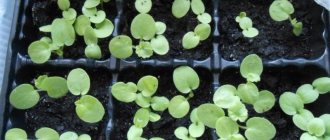Growing problems, diseases and pests
The presence of diseases is determined by the general condition of the crop and its appearance. Some specimens may exhibit yellowing of the leaf blades, dryness or lethargy, which can indicate serious problems:
- gray spots on the green part indicate the development of gray rot, the source of the damage is excessive waterlogging of the substrate;
- insufficient lighting is manifested by elongation of shoots and lack of peduncles;
- a reddish tint to the leaf blades appears at low temperatures.
Parasitic insect attacks have their own symptoms:
- Spider mites - attack crops when indoor air is too dry. It manifests itself as drying of the foliage and silvery cobwebs on the green part.
- Mealybug - identified by a whitish coating on the plates. The attack occurs when the soil is constantly waterlogged.
- Whitefly - looks like miniature butterflies. The parasite quickly forms colonies and covers the entire plant.
Important! The occurrence of symptoms of a lesion requires therapeutic measures to save the diseased flower
How to deal with them
Fungicidal solutions are used to treat fungal pathologies. The plant is transplanted into a new container with fresh substrate; before the procedure, all affected areas are removed and sprinkled with activated carbon powder.
The fight against parasitic insects involves mechanically treating the green part with a cotton pad and soap solution and spraying it with insecticides. The event is carried out several times until the pests are completely destroyed.
Caring for pelargonium is not difficult; if you follow the rules, it will delight you with bright buds that do not fade within six months.
Conditions for growing at home
Pelargoniums in general and zonal ones in particular are unpretentious. To provide them with care at home, you do not need to withstand specific conditions.
But still, the plant puts forward certain requirements for annual flowering, and it is better to comply with them so that pelargonium regularly produces buds and delights with its appearance.
Place for a flower
For the development and growth of pelargonium, window sills oriented to the east or west with bright but diffused light are suitable.
Direct sunlight can cause burns on delicate leaves, so you should not place the flower pot on a south-facing window. But a lack of light will also have a negative impact on the plant - the lack of sun will result in a lack of flowering.
Temperature
The optimal temperature for a flower in summer is about +25 °C, and in winter - about +15 °C or slightly lower.
Attention! The seasonal difference is due to the need to provide the plant with a period of rest.
Air humidity
Pelargonium does not really need regular spraying, but in moments of particularly drying summer heat, you can slightly humidify the air around the flower, trying not to get it on the leaves, or place a tray with water nearby.
In general, ordinary room humidity is quite suitable for pelargonium.
Watering
Pelargoniums do not tolerate too wet, heavy soils. Stagnation of moisture causes the development of fungal diseases and sooner or later will lead to the death of the plant.
When watering, you should be guided by the rule: “It’s better to dry it a little than to overwater it a little.”
Attention! For irrigation, you should take settled water at room temperature.
Soil for zonal pelargonium
A substrate that is too nutritious will do a disservice: an excess of microelements will lead to an abundant growth of green mass to the detriment of flowering.
Usually for pelargonium they choose universal substrates for flowering plants or mix it themselves. In equal parts you will need:
- humus;
- turf land;
- peat.
To prevent root rotting, you can mix brick chips or charcoal into the substrate - they perfectly absorb excess moisture.
Advice! Add a little calcined river sand - this will increase the looseness of the soil and its breathability.
Feeding and fertilizer
Pelargonium, like any flowering plant, needs mineral support throughout its active cycle (from early spring to late autumn).
But at the same time, at the beginning of spring, nitrogen-containing mineral fertilizers are applied to stimulate the development of greenery. And after a month, nitrogen is canceled and potassium-phosphorus fertilizers are applied during irrigation with a frequency of once every 14–17 days.
This mineral support helps pelargonium produce the maximum number of inflorescences.
With the end of flowering, feeding is stopped. Excess nutrients will prevent the plant from going into hibernation, which can lead to a delay or complete absence of flowering next year.
Transplanting pelargonium
Young plants that have not reached three years of age are replanted annually in the spring. This is due to the active development of the root system.
Older plants are replanted every 2-3 years as the pot becomes small. The manipulation is planned for the spring, after the plant emerges from the winter dormancy period.
Trimming
Like any plant with abundant green mass, pelargonium needs regular sanitary and formative pruning.
Sanitary pruning is carried out throughout the entire period of active growing season, removing all broken or dried leaf blades and faded corollas.
Formative pruning is carried out after flowering:
- All elongated shoots are shortened by 1/3 of the total length.
- Cut off the central trunk.
- Give the bush the desired shape.
But you shouldn’t radically “shave” the plant: too much pruning is stressful for pelargonium, which can lead to delayed flowering.
Further care
Caring for Lake pelargonium includes standard activities familiar to all amateur gardeners.
Watering
Pelargonium Lake, as an originally African plant, tolerates drought quite well. But this does not mean that it does not need watering at all. They practice either abundant moistening of the substrate every 5-7 days, or moderate but frequent (once every 2-3 days). In extreme heat, they always switch to daily watering, allowing only the surface layer of soil to dry.
Water is poured under the root, excluding its contact with leaves, buds and inflorescences. If the plant is placed in direct sunlight, it can cause burns.
Pelargonium Lake is watered with settled water at room temperature. If it is too cold, the plant may react to even a single watering by yellowing the leaves and dropping buds. Excessively hard water changes the neutral balance of the substrate to alkaline, which interferes with normal growth and development of roots.
Loosening
It is recommended after each watering to ensure oxygen access to the roots. Loosen the substrate carefully, to a depth of no more than 4-5 cm, so as not to “catch” the root system. Ideally, this should be done after each watering, but at least 2-3 times a month is sufficient.
Fertilizer application
Abundant and prolonged flowering greatly depletes Lake pelargonium. Therefore, from the beginning of March to the end of October, fertilizers are applied every 2-2.5 weeks. It is better to use complex store-bought organomineral fertilizers designed specifically for pelargoniums and geraniums. If they are not available, universal products for decorative flowering indoor plants are also suitable.
Pelargonium Lake responds well to folk remedies. But such fertilizing can cause an unpleasant odor from the pot and attract pests. The flower categorically does not tolerate natural organic matter (especially fresh).
Store-bought complex fertilizers take into account the crop’s need not only for basic macroelements, but also for microelements (they contain them exactly in the proportions required by pelargonium).
Trimming
The top of the central stem and side shoots are pinched twice a year - in early spring and late autumn. In the first case, it is necessary to have time before the formation of flower buds. Regular pinching stimulates branching of shoots.
The plant quickly recovers even after shortening the stems to the state of “stumps”, so even dwarf Lake pelargonium can be formed. The “wounds” are immediately disinfected by sprinkling with activated carbon, cinnamon, and colloidal sulfur crushed to a powdery state.
In summer, only fading inflorescences are cut off. This will help preserve the decorative appearance of Lake pelargonium and avoid unnecessary waste of nutrients.
Every 5-8 years for Lake pelargonium, radical anti-aging pruning is recommended - a “stump” no more than 10 cm high is left from the central stem
Pelargonium Lake does not need mandatory winter rest. However, such “hibernation” increases the lifespan of the plant and promotes more lush and vibrant flowering. Therefore, in the first half of November it is recommended to move the pot to a bright but cool room.
Until the beginning of spring, the flower is not fed; watering is reduced to the required minimum, moderately moistening the substrate once every 10-12 days. They focus on the tone of the leaves - if they begin to sag, losing turgor, the plant needs to be watered.
Aftercare
In order for Lake pelargonium to delight with elegant flowering, it is important to surround the flower with competent regular care
Temperature
Pelargoniums (pelargonium) came from the hot climate of the South American continent. This is why they need the right temperature.
In summer it should be +23..+28 degrees, during the rest period (autumn, winter, early spring) - +12..+15 degrees.
Attention! In winter, you cannot place the pot on the windowsill above the radiator - dry air is harmful to the plant
Watering and spraying, humidity level
The plant is moisture-loving; the soil is irrigated when the earthen clod dries out. Spraying is not required, but some gardeners use a spray bottle as a way to kill dust.
To maintain a comfortable level of humidity, you can place a container of water next to the flower.
Loosening
After each watering, you should carefully loosen the soil to ensure oxygen access to the roots. This is done carefully, since pelargoniums have a superficial root system.
Fertilizing
The soil for Laque pelargonium should be fertilized from March to September. In this case, ready-made mineral complexes for flowering plants are used.
During the flowering period, they are fed with potassium fertilizers, without using nitrogen-containing ones - they cause rapid growth of foliage to the detriment of budding.
The plant needs high-quality care, only in this case it will not lose its decorative effect.
Trimming
Be sure to pinch the top, otherwise the bush will stretch upward, becoming like a “stick”. It does not form side shoots on its own.
Pruning is carried out until a flower bud forms.
Description of the variety
Pelargonium Laque is a beautiful flowering plant. The bush is compact, with a small number of leaves, but with lush flowering. The color of the leaf plate is rich green, with a black edging, thereby increasing its decorative effect. The inflorescences are large, salmon-colored.
Elegant bright petals of an amazing plant will improve your mood with their decorative effect.
It can be grown in pots on the balcony, in which case the height of the bush will not exceed 60 cm, or in open ground, in which case the plant will tend to rise a little more. However, in any case it does not exceed 1.2 meters.
It is important to remember that the flower needs to be pinched, otherwise the pelargonium will grow upward, causing it to lose its decorative effect and become like a stick.
The variety belongs to the dwarf zonal variety, suitable for home flower beds, greenhouses, and winter gardens.
For reference! This variety is not very common in Russia, so lovers of indoor plants often confuse its name. In reviews and on forums you can find the following names: Luke, pelargonium Like, Lake or even Lakey.
Common diseases and pests
Despite the fact that the plant is unpretentious and has good immunity, sometimes it succumbs to diseases and various pests. The main reason is violation of the rules of care. To make the plant look healthy and beautiful, you need to monitor the watering system, loosen the soil and pick off dry leaves that take away vitality.
The most famous diseases are the following:
- Fungal diseases. If dark spots begin to appear on the leaves, this indicates the presence of fungus. To combat the disease, you need to quickly remove all parts that are affected and treat the plant with fungicides. If the disease does not stop the plant, then it must be replanted by removing all damaged roots and treating the pot.
- Rust. Yellow-red spots appear on the leaves, then they dry out and begin to fall off. Usually the problem occurs due to high temperatures and exposure to direct sunlight. We remove all affected parts, treat the plant and move it to a suitable location.
- Late blight. The plant begins to rot and wither, rapidly falling off. The reason is excessive watering. If the flower has already been flooded, then it needs to be replanted. During transplantation, we remove all damaged and rotting parts of the plant. We treat the pot with manganese solution.
Ivy-Leaved Pelargoniums
Plants with long, thin stems and tough, ivy-like leaves covered with a thick cuticle that helps reduce moisture loss during drought.
The varieties of this group originated from the ivy-leaved pelargonium (Pelargonium peltatum); they differ in the size of the leaves, the color and shape of the flowers, the degree of terry, there are varieties with variegated leaves. They are divided into:
- true ivy-leaved pelargoniums (Ivy-Leaved Pelargoniums) - this includes varieties and hybrids in which there are practically or completely no signs of zonal pelargoniums.
- hybrid ivy-leaved pelargoniums (Hybrid Ivy-Leaved Pelargoniums) - this includes varieties in which the characteristics of both zonal and ivy-leaved pelargoniums are clearly visible.
Plant Collectors Data Bank
| Search for plants by name | Nurseries by region | Selling plants | Plant photo galleries |
| Peony photo galleries | Photo galleries of perennials | Photo galleries of flowers | Photo galleries of fruits |
| Photo galleries of shrubs | Photo galleries of irises | Phlox photo galleries | Houseplants |
| Photo galleries of garden flowers | Photo galleries of indoor flowers | ||
Photos of pelargoniums and names of varieties from the collection of A.N. Kostyrina, Bryansk region
Description of the composition of the entire Pelargonium collection by mail
Zonal pelargoniums with double (Double Zonale), semi-double (Semi-Double Zonale) and simple (Single Zonale) flowers get their name due to the concentric zone of a darker color, which is located in the middle of the leaf. They are the most common and are known as "indoor geraniums".
Pelargonium Sarah Hunt | Pelargonium Warrenorth Pearl | Pelargonium Bold Pixie | Pelargonium Bold Pixie | Pelargonium Sarah Hunt |
Pelargonium Creamery | Pelargonium Ray Bidwell | Pelargonium Pac First Yellow | Pelargonium Pac Blue Wonder | Pelargonium PAC Harmony |
Pelargonium Warrenorth Pearl | Pelargonium Pac Blue Wonder | Pelargonium Elmsett | Pelargonium Pac Shocking Violet | Pelargonium Bold Sunset |
Pelargonium Peppermint Twist | Pelargonium Red Explosion | Pelargonium Pac Blue Wonder | Pelargonium High Tor | Pelargonium Tie Die |
| Pelargonium White Butterfly | Pelargonium Jessica | Pelargonium PAC Viva Maria | Pelargonium PAC Viva Maria | Pelargonium Tie Die |
Pelargonium Magnus | Pelargonium Pac First Yellow | Pelargonium Frou Frou | Pelargonium Tresor | Pelargonium Shimmer |
| Pelargonium Warrenorth Pearl | Pelargonium Abba | Pelargonium Happy of New Life, foliage | Pelargonium Angelique | Pelargonium Regina |
Pelargonium Frou Frou | Pelargonium Red Explosion | Pelargonium Emperor Nicholas | Pelargonium Odensjo Appolonia | Pelargonium Ainsdale Duke |
| Pelargonium Joy | Pelargonium Helen | Pelargonium Red Explosion | Pelargonium Red Explosion | Pelargonium Mr Wren |
| Pelargonium Sussex Gem | Pelargonium Emperor Nicholas | Pelargonium Golden Anniversary | Pelargonium Great Bricett, foliage | Pelargonium Americana White Splash |
Pelargonium Emperor Nicholas | Pelargonium Ivory Snow | Pelargonium Minx | Pelargonium Americana White Splash | Pelargonium Kronprinsesse Mary |
| Pelargonium Elmsett | Pelargonium Odensjo Poetry in Motion | Pelargonium Golden Anniversary | Pelargonium Skies of Italy | Pelargonium Peter Read |
Pelargonium Bills Gem | Pelargonium Elspeth | Pelargonium Laureen Alexandra | Pelargonium Lara Harmony | Pelargonium Alex Kitson |
| Pelargonium Orangesonne | Pelargonium Magnus | Pelargonium Deacon Finale | Pelargonium Sussex Gem | Pelargonium Cupid |
| Pelargonium Jessica | Pelargonium Flirt | Pelargonium Golden Anniversary | Pelargonium Dylan Cherone | Pelargonium Golden Choice |
| Pelargonium Kronprinsesse Mary | Pelargonium Lake | Pelargonium PAC Salmon Princess | Pelargonium Wendy Read | Pelargonium Creamery |
| Pelargonium Davina | Pelargonium Elmsett | Pelargonium Dibbinsdale | Pelargonium PAC Flower Fairy Berry | Pelargonium Davina |
Pelargonium Dovepoint | Pelargonium Elmsett | Pelargonium Warrenorth Platinum | Pelargonium Vina | Pelargonium Kennys Double |
| Pelargonium Dovepoint | Pelargonium Lara Harmony | Pelargonium Odensjo Rodluvan | Pelargonium Tresor | Pelargonium Doods Super Double |
Pelargonium Golden Choice | Pelargonium Bold Sunset | Pelargonium Warrenorth Carneleon | Pelargonium Shimmer | Pelargonium Brooks Purple |
Pelargonium Warrenorth Kunzite | Pelargonium White Butterfly | Pelargonium Kennys Double | Pelargonium High Tor | Pelargonium Great Bricett |
| Pelargonium Carousel | Pelargonium Warrenorth Citrine | Pelargonium Edmund Lachenal | Pelargonium Meadowside Orange | Pelargonium Minx |
| Pelargonium Ibiza | Pelargonium Vectis Embers | Pelargonium PAC Viva Madeleine | Pelargonium Carousel | Pelargonium Minx |
Pelargonium Mrs. Eve Scott | Pelargonium Brenda Hyatt | Pelargonium Norrland | Pelargonium Natalie | Pelargonium Askola |
| Pelargonium PAC Viva Madeleine | Pelargonium Alex Kitson | Pelargonium Bold Pixie | Pelargonium Mrs. Eve Scott | Pelargonium Creamery |
| Pelargonium PAC Viva Rosita | Pelargonium Video Blush | Pelargonium Helen | Pelargonium Mimi | Pelargonium Jyvaskyla |
| Pelargonium PAC Viva Rosita | Pelargonium Dovedale | Pelargonium ERAs Blodroda | Pelargonium PAC Flower Fairy Velvet | Pelargonium Elnaryds Clarissa |
Pelargonium Frou Frou | Pelargonium Double Pink Birds Egg | Pelargonium Sunstar Cherry | Pelargonium Norrland | Pelargonium Odensjo Rodluvan |
Pelargonium Camisole | Pelargonium Edwards Toscana | Pelargonium Happy of New Life | Pelargonium Regina | Pelargonium Warrenorth Thulite |
| Pelargonium Brocade | Pelargonium Pretty Petticoat | Pelargonium Odensjo Hummingbirds Egg Butterfly | Pelargonium Orchid Paloma | Pelargonium Frou Frou |
| Pelargonium Frou Frou | Pelargonium Pebbles | Pelargonium Telstar | Pelargonium Baby Brocade | Pelargonium Tamara |
Pelargonium Golden Choice | Pelargonium PAC Viva Maria |
Growing problems and pests
The main pests of pelargonium are the root bug, which spoils the roots of the plant, and the whitefly, which likes to settle on the inside of the leaves. The appearance of root worms is promoted by excessive soil moisture. Insecticides are used to combat it. But in the case of damage to the root system, it is better to say goodbye to the flower and replant the cut off tops of the plant in new soil.
If you create suitable conditions for a perennial flower, it will delight you with its unique color for a long time. The main thing is not to overdo it with watering.
vote
Article Rating
Winter care
Optimal wintering conditions can be created on a glazed, frost-free, well-lit loggia or in a greenhouse. It is necessary to maintain a minimum temperature at night not lower than +6°C, in the daytime - about +12+15°C. In case of overheating on sunny days, open the greenhouse doors for ventilation. Angels, bicolor and tricolor varieties are best kept at higher temperatures, placing them in warmer places in the greenhouse or loggia.
Good air circulation around the plants is required; they should not be placed too closely; if necessary, the dense roots should be thinned out a little. This will help avoid the occurrence of fungal diseases. Watering during this time is quite sparse; experienced gardeners carry it out from pallets, clearly measuring the amount of water and determining the time of the next watering by the weight of the pots, while the top of the soil is always left dry.
There are other ways of wintering. One of them is to preserve plants in the form of rooted cuttings, while the mother plant is thrown away. The method is used for summer cultivation of pelargoniums in the open air.
The second method is also used for outdoor growing: on the eve of frost, the plant is dug up, excess soil is shaken off the roots, the plant is heavily pruned and wrapped in paper, then hung in a cool basement. The room should have good ventilation and high humidity so that the plant does not dry out. In the spring it is planted in a pot, and with the onset of warmth it is planted in open ground. You can combine the first and second methods: first take cuttings, and then send the mother plant to the basement for the winter.
Wintering occurs during the darkest time of the year and lasts approximately 2.5-3 months (from November to February). Already at the end of January - beginning of February, with increasing daylight hours, pelargoniums gradually begin to wake up.
Pelargonium zonal description
Pelargonium zonalis is distinguished by large, brightly colored flowers, collected in large dense or loose umbrella-shaped inflorescences. The flowers are simple, semi-double, double and densely double. The color of the petals is very diverse - white, pink, bright red of various shades, lilac, purple. Often two-colored, with a bright eye in the center or a border around the edge. The leaves are round, softly pubescent, on long stalks. The color is green with a concentric-zonal pattern. There are varieties with brown leaves and variegated (tri-zonal). Plant height varies from 15 to 75 cm.
Origin. South and South West Africa.
Story. Zonal pelorgonium first appeared in Europe at the beginning of the 18th century.
Varieties. Varieties of zonal pelargonium were obtained by crossing Pelargonium zonale L'Herit. ex Ait with other species - Pelargonium cucullatum Ait. (Pelargonium cap), Pelargonium inquensis Ait. (Pelargonium settlers), as well as with some other species and forms. Mutant varieties are available.
Varieties differ in plant height, shape and color of leaves and flowers.
In total, more than a thousand varieties are known.
Varieties: grown from seeds:
- Caprice - with coral-pink flowers.
- Sprinter - with bright red flowers.
- Ringo - with red flowers.
- Playboy - mixed colors, leaves with a bronze tint, small flowers.
Varieties from Cerny company. :
Jitka F1 - Simple salmon flowers. The leaf is green with a brown tint along the edge.
Blanca F1 - Flowers are simple white. The leaf is green with a brown tint along the edge.
Pelargonium 'Yarka F1'
Pelargonium 'Paul' F1
From cuttings grown:
- Paul Krempel - with simple red flowers.
- Irene - with semi-double light cherry flowers.
- Gustav Emich - with red double flowers.
- Youth - with pinkish-oriage double flowers.
- Jewelry chest - with orange-red double flowers.
Temperature. Seeds germinate at temperatures of 21 °C and above. The shards must be heated from below (up to 18 °C). Harden off the plants gradually. Geraniums do not tolerate frost.
Illumination. Seedlings indoors need good lighting. Cuttings need to be shaded during the rooting period. Mature plants require good lighting on a sunny windowsill, but indirect light is also suitable.
Watering. You can use unsettled tap water. The soil in the container should dry out between waterings.
Air humidity. Keep pelargonium zonalis dry and do not spray it from above.
Feeding. Feed the plant in the soil mixture once a week; in a soilless substrate - every 3 days. Use liquid fertilizers, diluting them 2 times weaker than the manufacturer recommends. If the plant grows well outdoors, use fertilizers in the concentration recommended by the manufacturer.
The soil. Use a soilless substrate to sow seeds and root cuttings. Plant an adult plant in fertile clay soil or a mixture for indoor plants.
Transfer. .
Appearance care. Remove faded flower umbels by cutting off the flower stalks at the base.
Reproduction. Take cuttings from plants planted on the balcony in mid-summer or early autumn. Indoors, cut them back in early fall or early spring. Root 3-4 cuttings in a 10 cm pot. Heat cuttings of indoor plants from below (18 ° C). Sow seeds in early spring in moist soil and germinate them at temperatures of 18 °C and above.
Peculiarities. Cuttings. Select a shoot with at least two leaf piles and a growing point and cut the stem under the lower leaf pile (about 10 cm long). Cut the cutting diagonally again so that the cut surface is smooth. Remove the bottom two leaves. Dip a cutting cutting into rooting hormone powder and place it near the edge of a pot filled with seedling potting mix.
Usage. One of the most common indoor plants. An excellent material for landscaping balconies. It is used in landscape design when planting lawns as a one-year plant. When gardening in containers, in order for the plant to overwinter, it must be brought indoors and kept until next spring in a cool, dry, well-lit place.
Description of the pelargonium variety Lake and its characteristics
The Lake variety is part of the group of zonal or rosebud pelargoniums. Breeders are most willing to experiment with them; now there are more than a thousand varieties and hybrids they have bred based on “natural” zonal pelargoniums. Their popularity is due to their undemanding conditions for cultivation and care.
Pelargonium zonalis Lake is not the most common variety in Russia. Therefore, its name is often “misinterpreted”. It is not called “Lake”, but “Like”, “Lake”, “Leiki”, “Luke”.
In nature, zonal pelargonium in a subtropical or tropical climate that is optimally suitable for it with sufficient air humidity is a tree 2-3 m high. The Lake variety can also be grown as an outdoor crop, then the bush will grow to 1-1.2 m. But much more often it turns into a potted plant.
In captivity, the height reaches a maximum of 60-65 cm. Regular competent pruning can turn Lake pelargonium into a miniature one (up to 20-25 cm).
Unlike the grandmother’s pelargoniums that are familiar to many, which look unaesthetic due to the fact that they represent one strongly elongated central stem, the Lake variety has shoots that branch intensively (especially with proper pruning).
As a result, a neat, not too densely leafy bush is formed. Its root system is developed, the roots are long. This must be taken into account when choosing a pot.
The bush cannot be called densely leafy, but it does not give the impression of being “bald” either.
Leaves and flowers
From the “natural” zonal pelargoniums, the Lake variety inherited their main distinctive feature. Approximately in the middle of the leaf blade there is a wide, blurry chocolate-brown stripe, which contrasts brightly with the main rich green background. Its outline follows the contours of the leaf (a rounded carved shape, classic for pelargonium and geranium).
Depending on growing conditions, the chocolate-brown border on the leaves may have a greenish or purple undertone.
Lake pelargonium blooms abundantly and long-lasting. If you provide it with minimal care, inflorescences form almost without interruption, all year round. Their average diameter is 8-10 cm, the shape is close to a regular ball.
The flowers are double and have a salmon-peach hue, atypical for pelargoniums. Moreover, the color is gradient - the edges of the petals are light, creamy, and closer to the base the color becomes rich, peachy-pink.
But the full decorative effect of flowers appears only with sufficient lighting. In the shade the petals fade greatly. But 2-3 days in the sun and open air are enough for the plant to become noticeably brighter.
The color of the flowers of each specimen of Lake pelargonium is unique - it depends on the composition of the soil, the indoor microclimate, and other factors
Planting and propagation
Pelargonium is propagated vegetatively and by growing from seeds. Each method has its own characteristics associated with the methodology of work.
Propagation by cuttings
It is considered a simple and highly effective way to obtain a new plant. To do this, during the next pruning of the bush, cuttings from 10 to 13 cm long are prepared.
Excess leaves are cut off from the bottom and the cuttings are placed in water for germination or treated with preparations that stimulate root formation and buried 2–3 cm in the soil.
Roots usually form within three weeks.
Growing from seeds
This is a longer process:
- The seeds are laid out on the surface of the nutrient substrate without being buried.
- Moisten with a spray bottle and cover the container with glass or film, thus creating a greenhouse.
- Place the container in a warm, well-lit place and open it for a short time every day for ventilation.
- Water as the top layer of soil dries.
After the shoots emerge, the film can be removed.
https://youtube.com/watch?v=OZvGAx8hyfs%2520
Picking
After the pelargonium seedlings produce 2-3 true leaves, it’s time to plant, that is, plant them from a common container into separate pots.
Important! There is no need to rush into picking and planting seedlings as soon as they appear. The sprouts need to be given time to get stronger and form a normal root system. When picking, do not moisten the soil too much - this can worsen gas exchange, and the seedlings will not take root.
When picking, no additional fertilizers are applied: everything that is needed for the development of small pelargoniums is already contained in the substrate
When picking, you should not moisten the soil too much - this can worsen gas exchange, and the seedlings will not take root. When picking, no additional fertilizers are applied: everything that is needed for the development of small pelargoniums is already contained in the substrate.
Hardening
Since pelargonium is also cultivated as a garden annual, the seedlings are first hardened off before planting in a permanent place in the flowerbed. This procedure helps tender seedlings adapt to new conditions.
For hardening, the seedlings are taken out for 30–40 minutes, first on a loggia or enclosed terrace, and then outside. The time is gradually increased. Hardening lasts about a week, sometimes two weeks.
Important! When hardening, the air temperature should not be lower than +10 °C.
When to pinch out seedlings
In order for the pelargonium bush to produce abundant lateral shoots, to be lush and voluminous, in the phase of formation of the 6th leaf, the stem is pinched. This procedure helps to achieve more luxuriant flowering.
Sowing time
Pelargonium seeds are planted from the beginning of February to the end of March, at the latest in the first half of April. After this, landing makes virtually no sense.
Preparing seeds for sowing
To improve the germination of seeds, scarification is carried out - parts of the dense seed coat are removed due to mechanical action or soaking.
To do this, it is recommended to rub the seeds a little between two sheets of fine sandpaper and soak for 1.5–2 hours in water at room temperature.
The second option is to pour boiling water over the seeds and then cold water, pour hot water over the seed material and leave it like that for a day.
Planting and replanting Laque pelargonium
Pelargonium Laque does not like dense plantings. When planting it in open ground, do not forget about long roots, the distance between the bushes should be 20-30 cm, holes are dug to a depth of 20 cm. Planting in the soil is done in June, when the soil is no longer subject to frost.
Pelargonium Sutarve Clara San - variety characteristics and cultivation
On the windowsills in the apartment it is planted in medium-sized pots, 15-20 cm in diameter. It is better if it is a ceramic pot, it can protect the roots of the plant from high temperatures. In the absence of ceramic pots, you can plant in plastic ones, but be more careful about drying out the soil.
Note! Pelargonium begins to bloom only after the roots of the plant fill all the free space in the pot. Therefore, large containers for plants are not advisable.
Pelargonium prefers light, loose soil with a high content of sand and peat. A lack of nutrients in the soil can slow down the development of a plant and its flowering. A layer of drainage must be poured onto the bottom of the pot. Pelargonium Laque loves sunny areas, but partial shade is still preferable for it. It is advisable that the air temperature does not exceed 20-22 ° C, then flowering will be more abundant.
Important! The sand used for soil should not contain clay inclusions.
